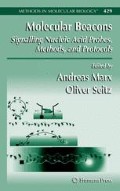Abstract
Fluorescence is highly sensitive to environment, and the distance separating fluorophores and quencher molecules can provide the basis for effective homogeneous nucleic acid hybridization assays. Molecular interactions leading to fluorescence quenching include collisions, ground state and excited state complex formation, and long-range dipole-coupled energy transfer. These processes are well understood and equations are provided for estimating the effects of each process on fluorescence intensity. Estimates for the fluorescein-tetramethylrhodamine donor-acceptor pair reveal the relative contributions of dipole-coupled energy transfer, collisional quenching, and static quenching in several common assay formats, and illustrate that the degree of quenching is dependent upon the hybridization complex formed and the manner of label attachment.
Access this chapter
Tax calculation will be finalised at checkout
Purchases are for personal use only
References
Lakowicz, J. R. (1983) Principles of Fluorescence Spectroscopy. Plenum Press, New York.
Valeur, B. (2002) Molecular Fluorescence: Principles and Applications. Wiley-VCH, Weinheim.
Morrison, L. (1999) Homogeneous detection of specific DNA sequences by fluorescence quenching and energy transfer. J. Fluores. 9, 187–196.
Morrison, L. E. (2003) Fluorescence in nucleic acid hybridization assays. In Topics in Fluorescence Spectroscopy, vol 7 (Lakowicz, J. R., ed.), pp. 69–97, Kluwer Academic Publications, New York.
Ebata, K., Masuko, M., Ohtani, H., and Kashiwasake-Jibu, M. (1995) Nucleic acid hybridization accompanied with excimer formation from two pyrene-labeled probes. Photochem. Photobiol. 62, 836–839.
Morrison, L. E. (1988) Time-resolved detection of energy transfer: Theory and application to immunoassays. Anal. Biochem. 174, 101–120.
Lakowicz, J. R. and Weber, G. (1973) Quenching of fluorescence by oxygen. A probe for structural fluctuation in macromolecules. Biochemistry 12, 4161–4170.
Forster, T. (1959) Transfer mechanisms of electronic excitation. Disc. Faraday Soc. 27, 7–17.
Morrison, L. E., Halder, T. C., and Stols, L. M. (1989) Solution-phase detection of polynucleotides using interacting fluorescent labels and competitive hybridization. Anal. Biochem. 183, 231–244.
Tyagi, S. and Kramer, F. R. (1996) Molecular beacons: Probes that fluoresce upon hybridization. Nat. Biotechnol. 14, 303–308.
Heller, M. J. and Morrison, L. E. (1985) Chemiluminescent and fluorescent probes for DNA hybridization systems. In Rapid Detection and Identification of Infectious Agents (Kingsbury, D. T. and Falkow, S., eds.), pp. 245–256, Academic Press, Orlando.
Wittwer, C. T., Herrmann, M. G., Moss, A. A., and Rasmussen, R. P. (1997) Continuous fluorescence monitoring of rapid cycle DNA amplification. Biotechniques 22, 130–138.
Lee, L. G., Connell, C. R., and Bloch, W. (1993) Allelic discrimination by nick-translation pcr with fluorogenic probes. Nucleic Acids Res. 21, 3761–3766.
Ishiguro, T., Saitoh, J., Yawata, H., Otsuka, M., Inoue, T., and Sugiura, Y. (1996) Fluorescence detection of specific sequence of nucleic acids by oxazole yellow-linked oligonucleotides. Homogeneous quantitative monitoring of in vitro transcription. Nucleic Acids Res. 24, 4992–4997.
Abravaya, K., Huff, J., Marshall, R., et al. (2003) Molecular beacons as diagnsotic tools: technology and applications. Clin. Chem. Lab. Med. 41, 468–474.
Author information
Authors and Affiliations
Editor information
Editors and Affiliations
Rights and permissions
Copyright information
© 2008 Humana Press Inc., Totowa, NJ
About this protocol
Cite this protocol
Morrison, L.E. (2008). Basic Principles of Fluorescence and Energy Transfer. In: Marx, A., Seitz, O. (eds) Molecular Beacons: Signalling Nucleic Acid Probes, Methods, and Protocols. Methods in Molecular Biology, vol 429. Humana Press. https://doi.org/10.1007/978-1-60327-040-3_1
Download citation
DOI: https://doi.org/10.1007/978-1-60327-040-3_1
Publisher Name: Humana Press
Print ISBN: 978-1-58829-700-6
Online ISBN: 978-1-60327-040-3
eBook Packages: Springer Protocols

